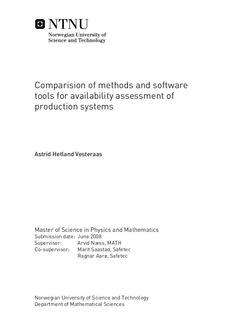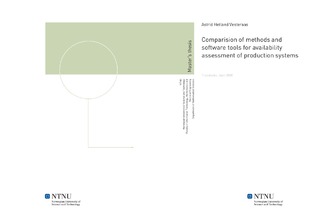| dc.description.abstract | This thesis presents and considers several different methods for computation of availability and production availability for production system. It is assumed that the system handles flow of a fluid. The thesis presents two software programs for computation of reliability measures, MIRIAM Regina and Relex Reliability Studio, and several analytical methods, among them one especially adapted to computation of production availability. For the methods not able to compute production availability, a method is presented which makes it possible to estimate production availability from computation of availability. Among the methods, Relex and three of the analytical computation methods are made to compute availability of the system. The analytical methods considered are standard availability computation based on the structure function of the system and the definitions of availability and computation based on renewal and quasi renewal processes. Relex makes it possible to compute availability both by simulation and, if the system is simple enough, by analytical methods. The usefulness of the analytical methods is to an extent limited by the assumptions laid on the system. Relex makes it possible to take into account more features one would expect to have in a real life system, but for analytical methods to be employed in the computations, the system must be quite simple. Two methods especially made for computing production availability are presented. These are the software program MIRIAM Regina, which combines a sophisticated flow algorithm with Monte Carlo simulation, and a method based on using Markov chains for computing the probability distribution for flow through subsystems of the system under consideration, and then employing simple merging rules to compute the flow through the entire system. These methods are both very flexible, and makes it possible to take into account many different aspects of a real life system. The most important source of uncertainty in the results form a computation, lies in the relation between the real life system and the model system computations are made on. A model system will always be significantly simplified. When choosing a computation method and interpreting results, it is important to keep in mind all assumptions made regarding the system, both explicitly when making the model, and implicit in the computation method. Another source of uncertainty is uncertainty in the input data. A method for propagation of uncertainty through computations is presented and employed on some of the methods. For simulation, one will in addition have the uncertainty due to simulation being an way of making a statistical sample. The size of the sample, given by the number of simulation iterations done, will decide the accuracy of the result. | nb_NO |

